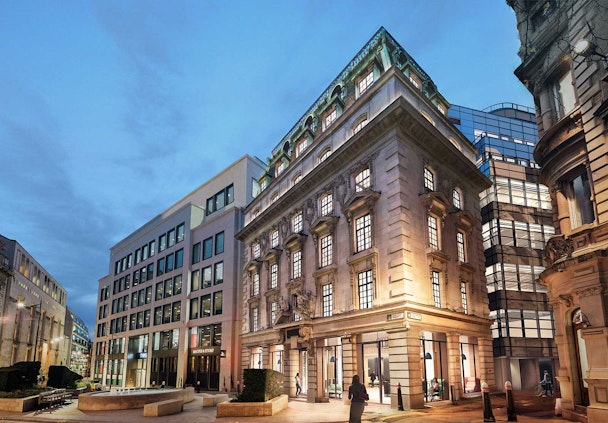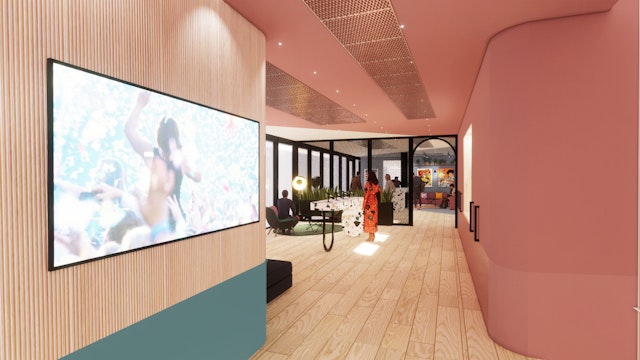Rebuilding the future: as workers return, how are agencies reimagining the office?
With staff returning, agencies are reimagining offices as smarter, greener and more centralized than ever before. We ask agency leaders how – and why – they’re reimagining the workplace.

IPG Mediabrand’s new London HQ, The Bailey, may be the archetypal new office
After 18 months of working from home, adland staffers are slowly trickling back into the workplace. But for ad agencies across the world, the purpose of the office has changed entirely.
While some marketing businesses, such as formerly London-based The Goat Agency, have permanently evacuated their offices, most agencies are sticking with a physical base. VMLY&R New York, for example, is condensing the Manhattan branches of VMLY&R Commerce, VMLY&R Health, Taxi and Berlin Cameron into a single flagship location at Columbus Circle.
But the status of the office as the only place work can be done has been challenged. And with real estate one of the biggest costs for any business, the future of the office is under review.
The office of tomorrow, built in 1912
That future might look quite a bit like IPG Mediabrands’ new British headquarters The Bailey. Well, new-ish. Its new HQ was erected in 1912, crafted from Portland stone in the Edwardian Baroque style. UK and Ireland chief exec Richard Morris says all eight floors of the building have been ”gutted” as part of a huge redesign.
And while the renovation was planned prior to the pandemic, the new ways of working its staff demand (though 90% of its staffers want the option to work in an office, an internal IPG survey found 75% don’t want to be there more than two or three days a week) have been plumbed in.
In an email, Morris tells The Drum: “Work/life balance is key and we want to support both our teams and clients however they prefer to work. As such, we recognized the most sensible and equitable option is to give people the flexibility to work from wherever they choose, whenever they choose to do so.
“Consequently, we invested in the latest IT/AV infrastructures to bring people together regardless of whether they are on-location or working remotely. If we’re to get the most out of our teams, and give everyone a fair opportunity to progress their careers, then we needed to ensure those dialling in virtually have the same opportunities to actively participate.”
Kitted out with space for guest speakers, no-screen zones, a multi-faith prayer room and quiet spaces, it is intended to maximize the benefits of working in person, which are particularly stark for junior employees. “Factors like culture, mental health, on-the-job training and learning by osmosis can be just as important as flexibility. This is especially true for people near the start of their careers, as after all not everyone’s home workspace is the same, or indeed adequate,” says Morris.

It’s also been built with sustainability “front of mind”. The redesign was handled by surveyors Gardiner & Theobald, architecture practice MCM and engineering firm Cundall. “We wanted to be green design first to make sure the building is future-fit and meets the needs of environmentally-conscious staff.”
The goal, he says, is for The Bailey to be “more than just an office”.
“We want it to be a community unto itself and it will be open to both staff and clients. It is designed as a place to rekindle face-to-face client relationships and encourage creative collaboration. The building’s client meeting spaces and conference rooms are located on the top floor that overlooks London. The rooftop terrace will allow teams and clients to socialize with some of the best views in the city.”
What about existing premises?
Just because staffers haven’t been present doesn’t mean their desks have been gathering dust. At Ogilvy and Wunderman Thompson, the interiors of their formerly deserted offices have been reimagined with modular furniture.
Fiona Gordon, Ogilvy UK chief executive, explains that the agency used remote working as an opportunity to get some building work done at Sea Containers House, WPP and Ogilvy’s mothership on the Thames. ”We’ve made a new space on our first floor, which we call The Yolk, which is a modular space.
”You can create the space you want ... you can make it into an amphitheater or you can make small workspaces. You can use it for workshops, tissue sessions, talks.”
As well as creating new facilities from existing space, she says it should provoke more meaningful office work. ”It means when you do come to the office, you’re not just sitting on Microsoft Teams all day – you’re actually interacting with people and doing with a benefit to being together.”
At Wunderman Thompson, UK chief exec Pip Hulbert says the agency has put much of its furniture on castors, with a similar aim in mind. Office spaces can now be rearranged at a moment’s notice, allowing for a more flexible approach to the workspace.
”I know we’re not gonna win any sort of great thinking prizes for that. But what it does mean is that we can change space really, really quickly,” she explains. ”If you need it to be a meeting, or you need it to be a pitch room, everything can just be moved around quite quickly. I can’t tell you how effective that is.”
At the same time, its premises are now better equipped to accommodate hybrid teams, with additional soundproofing added to meeting rooms (so video conferences don’t lead to noise pollution in the rest of the office).
What about regional offices?
What about opening new offices altogether? Opening an outpost in a new market is still a powerful way for marketing businesses to expand in regional markets.
When sports marketing specialists Wasserman opened a new office in Düsseldorf recently – its first in Germany – it opted for a serviced office to cut costs and support the small team it has in the territory. Lenah Ueltzen-Gabell, managing director EMEA at Wasserman, says a presence in the financial center was important because ”the area is full of great local talent to tap into”.
She says: ”It is also convenient to mobilize across Europe, and demonstrates a key strategic moment in our pan-European growth.”
Still, it’s limiting investment – reflecting a leaner approach to real estate. ”We don’t want to be investing time and money on our overheads when this resource can be better spent on our clients,” says Ueltzen-Gabell.
In stark contrast, WPP’s Mark Read recently cut the ribbon on a new ’campus’ in Milan, designed by the holding company’s architecture practice BDG Architecture + Design to accommodate 35 agencies and 2,000 staff.
At 27,000 square meters and taller than the famous Duomo di Milano, it’s a major investment.
Questions of architecture and furniture design aside, it’s likely that hybrid work arrangements will still be the biggest change to the office. Despite the cash ploughed into their respective building projects, neither WPP nor IPG Mediabrands expect to see their offices packed with eager executives.
WPP plans to have a 70-30 split between office workers and remote staff at its new Milan location. And at IPG, Morris says: ”Our model will see staff spend half their time at The Bailey, because it brings back the joy of working together.
”Lots of people are tired of Zoom and Teams and want to be able to meet up, share ideas and get back to something approaching normality.”

